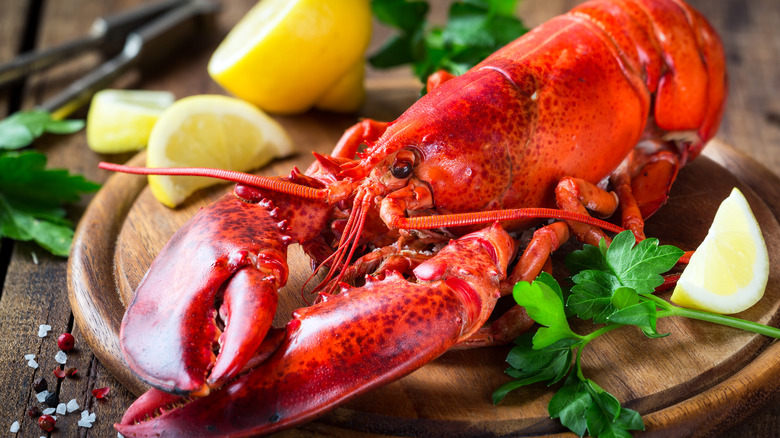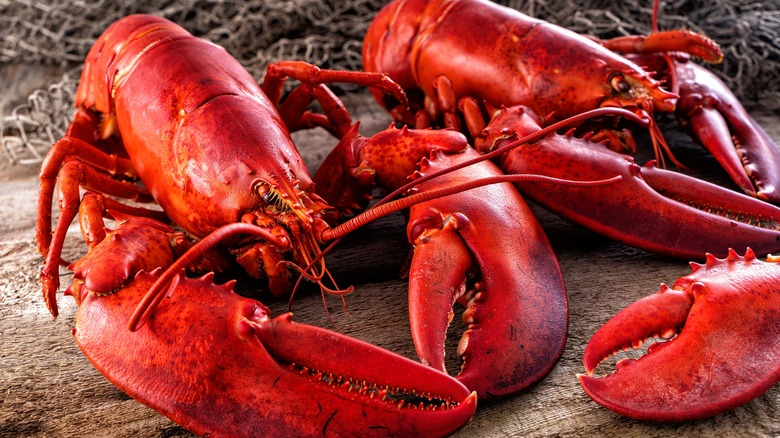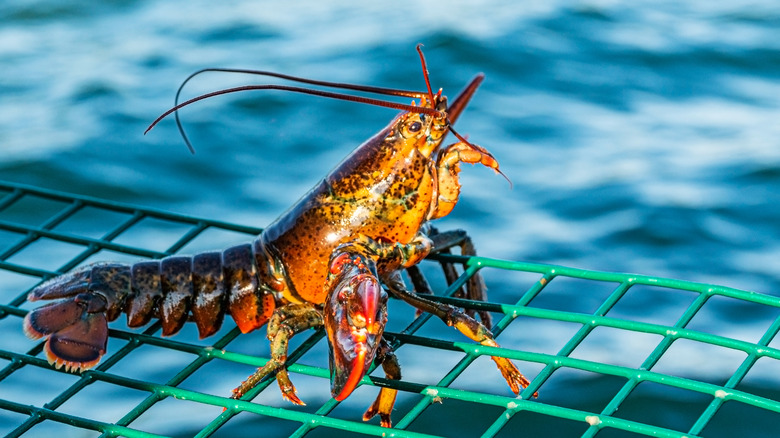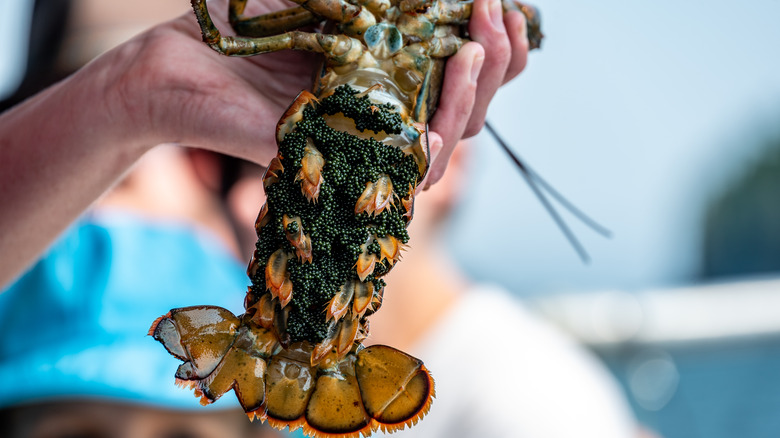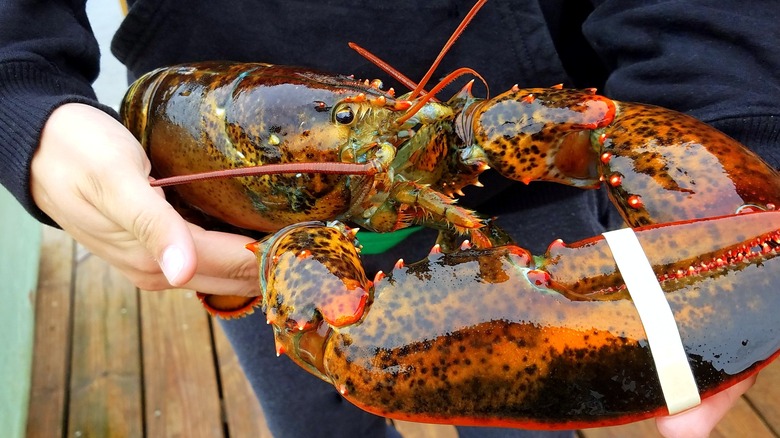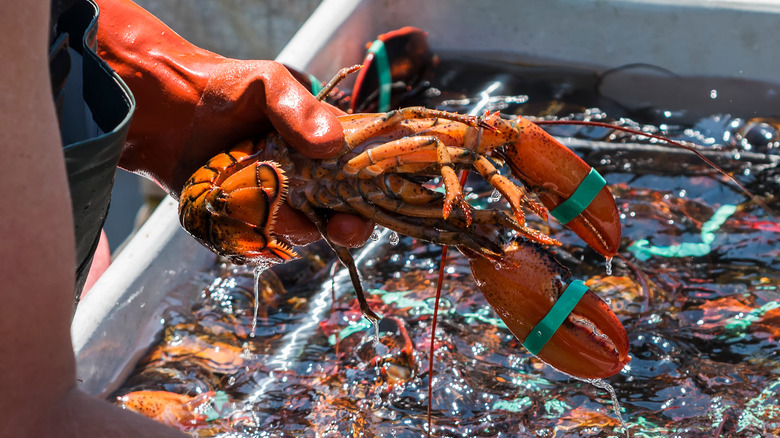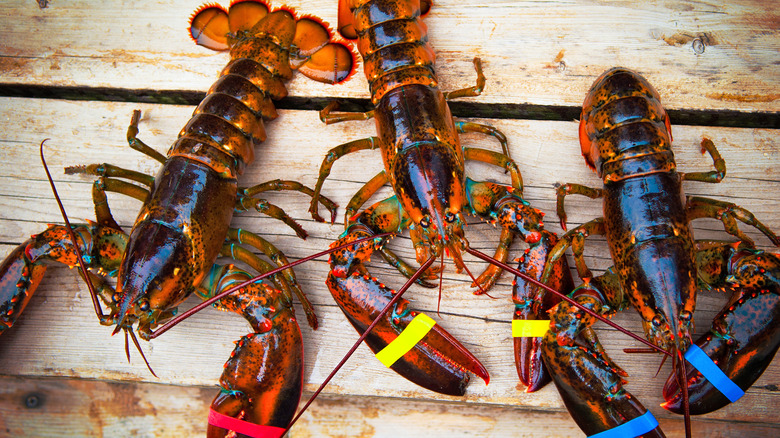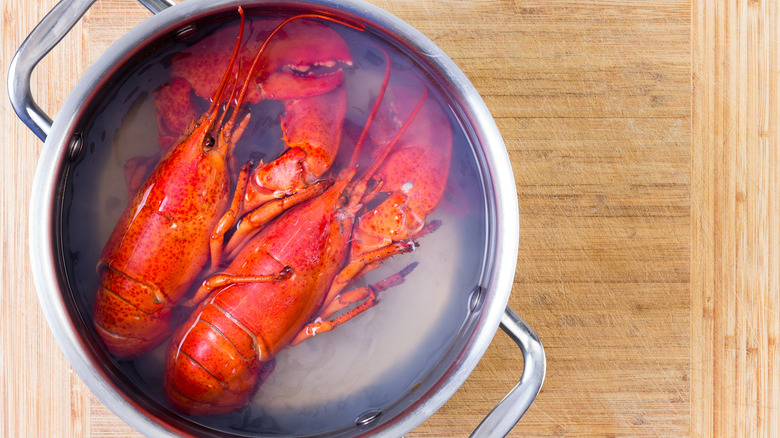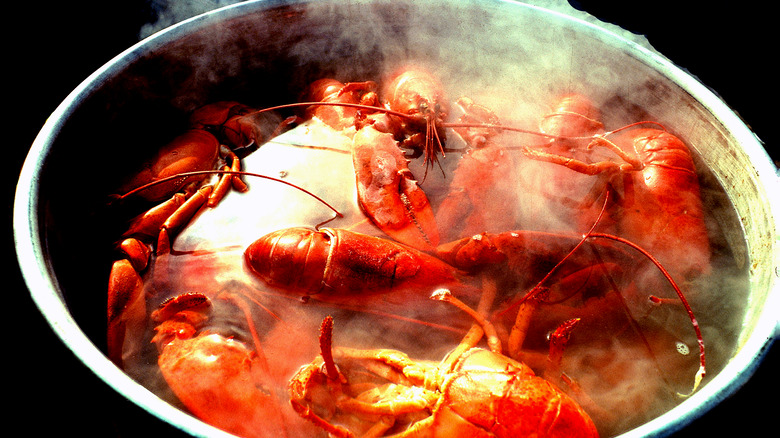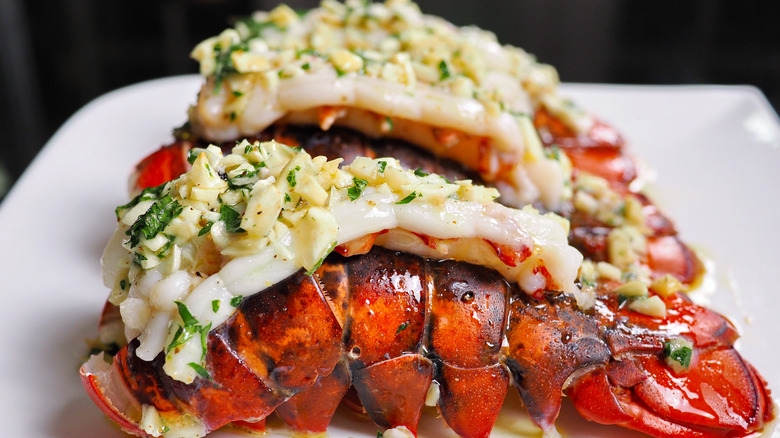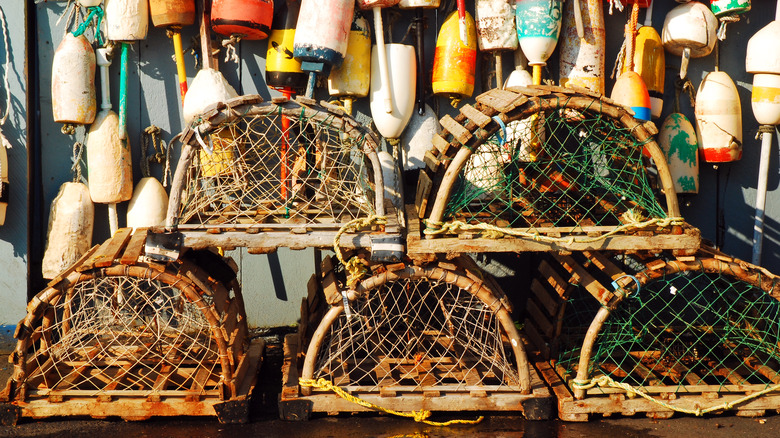10 Lobster Myths It's Time You Stopped Believing
Lobster represents a unique success story in the food industry. They look like sea bugs and were previously considered to be the "poor man's protein": Lobster were so plentiful (and disdained by the general population) that they were seen as only suitable to feed prisoners. No, that story is not a myth. By the late 1880s, the narrative shifted when lobster started appearing on restaurant menus, and it's now an ultimate sign of luxury (via History).
With so many widely believed myths about lobster, we wanted to try and bust some of them. To help with this task, we spoke to a few industry experts. Bruce Fernald is a sixth generation Maine lobsterman in Little Cranberry Island, Maine. Curt Brown is commercial lobsterman in Cape Elizabeth, Maine, and also a marine biologist at Ready Seafood. For the culinary perspective, we spoke to Steve Kingston, chef-owner of The Clam Shack in Kennebunkport, Maine. His acclaimed lobster roll is considered one of America's best lobster rolls. They will help us get to the truth behind these popular lobster myths.
Lobsters mate for life
While it's unclear where most of these myths started, you can identify some works in popular culture that perpetuate them. Fans of the hit TV show "Friends" will remember Phoebe explaining that Rachel is Ross' lobster. She then confidently declares "It's a known fact that lobsters fall in love and mate for life." Over 25 years later, this scene is still one of the most iconic moments from the show and a cultural reference point. You can find a numerous examples of merchandise available online with the words "you're my lobster" displayed on them, specifically marketing as being associated with the show.
It's a lovely thought that lobsters mate for life, but it turns out there is no truth to this legend. Commercial lobsterman Curt Brown explains that not only are lobsters not monogamous, they aren't even known for having long-term partners. Brown states, "A dominant male lobster will mate with multiple females it encounters that last up to several weeks." Bruce Fernald adds that lobsters will dig themselves a spot to live under a pile of rocks, and while they may leave space for a female, the male will still mate with several females. We may want to believe our true "lobster" is out there waiting for us, this concept is definitively a myth.
Lobsters are immortal
Without intervention from humans or other ocean predators, lobsters have the potential to live long lives. As Bruce Fernald explains, lobsters can live for over a hundred years. In terms of animal species, that is an impressive potential lifespan. It's understandable how a myth of immortality has circulated given the mystique of this animal.
Aside from its predators, there are natural causes that could lead to a lobster's death. They contract shell disease, a bacterial infection that can kill a lobster if it is not able to shed its shell before the illness reaches advanced stage (via NOAA). Since older lobster molt less often, they are more susceptible to death from this disease. Molting also poses its own risks for elderly lobsters — they can die from exhaustion, as the process of shedding their exoskeleton might require them to exert too much energy (via McGill).
Even though older lobsters molt with less frequency, Brown points out that lobsters never stop growing. They get bigger each time they shed their shell, and he notes that the largest known catch weighed over 40 pounds (the 44-pound lobster that was caught in 1977 has yet to be trumped).
Female lobsters taste better
Can you tell the difference between the meat of male and female lobsters? Some people claim they can, but chef Steve Kingston disputes the myth that females have the superior flavor. He calls the meat from each "equally delicious." Kingston attributes this fallacy to people's fascination with roe (unfertilized eggs). Roe is a culinary treat. For chefs, unknowingly buying a lobster that contains roe may similarly feel like finding a $20 bill on the ground. You didn't ask for it, but you can certainly benefit from the possession.
It is important to note, however, that the industry has protections in place for female lobsters are intended for the preservation of the species. In Maine, it is illegal to catch or sell a female lobster visibly bearing eggs on its underside, as well as female lobsters with a "v-notch" (via Maine Legislature). These egg-bearing females are given this v-shaped marking on the right flipper on their tail to indicate they are able to reproduce, which is an immediate indication that the lobster must be thrown back into the ocean. Juvenile and oversized lobsters are also protected with the same system, explains Fernald. So, female lobsters may be more prized but there is no objective proof that their meat tastes any better than a male's.
Big lobsters are tough
Succulent lobster is a gift to your tastes buds, so wouldn't you want more? While your eyes may love the sight of a huge tail or claw to sink your teeth into, there has been a longstanding belief that big lobsters are not good to eat. As it turns out, the jury is still out on this myth. Maybe bigger isn't always better.
Representing the chef perspective, Kingston says big lobsters are tough when it comes to technique. Kingston's explanation is that larger lobsters are more difficult to fully cook "without producing tough tail meat." He would prefer two 1.25-pound lobsters to one 2.5 lobster, especially if the smaller lobsters are "new," meaning they recently shed their shells. Martha Stewart would likely agree: She instructs to boil 1.25-pound lobsters for 13 to 18 minutes but no longer to avoid overcooking.
On the other side, both Fernald and Brown both say large lobsters can be tough, but it depends on when they last molted. Fernald reveals that when a larger lobster has recently shed its shell, "The meat will still be sweet and flavorful." Brown adds, "If the lobster hasn't molted for a long time, the meat will be packed into the shell and will be tougher than a lobster that has shed more recently." It is possible to have an enjoyable larger lobster, but since the demand is higher for lobsters that weigh around 1.25 pounds, fishers will aim to catch more at that size.
Hard-shell lobsters taste the best
Lobsters molt, meaning they shed and grow new shells. Depending on how long ago a lobster molted, its shell can range from very soft to rock-hard. There is a belief that the hard-shelled lobsters taste the best.
Kingston, however, completely disagrees with this sentiment and prefers the meat from recently shed lobsters: "When I compete in lobster roll competitions or am serving a well-known chef at my shack, I always use a beautiful Maine, new-shell lobster for the sweet flavor. The sea water between the shell and the meat creates the perfect cooking environment." You might wonder why there seems to be a preference for hard-shelled lobsters. Kingston speculates that it has to do with the fragility of soft-shells. He notes that hard-shelled lobsters are "heartier" and can better survive shipping.
Both Brown and Fernald express that this is a matter of personal preference. The lobster fishers each favor the "new" lobsters for their sweet flavor. Fernald says, "We've done blind taste tests all around the country and found that the vast majority of people prefer the taste of the soft shell lobster." Brown additionally explains that during molting "the shell fills with sea water, which effectively brines the meat, giving it a sweet flavor and tender texture." Hard-shelled lobsters may be easier to send long distances, but if you are able to locally source this crustacean, it may be worth it to seek these "new" soft-shelled lobsters.
Weak lobsters should not be eaten
It's an undisputed principle that you should not consume dead lobsters. This is true for all crustaceans. Shellfish like lobster are hosts to harmful bacteria, which can typically be destroyed by cooking. The bacteria multiply very rapidly after a crustacean's death, drastically increasing your risk of foodborne illness. If that's not enough reason to avoid eating dead shellfish, Kingston claims that meat from a deceased lobster will be mushy after cooking. Not only is that an unappetizing image, the mushy meat gives a useful warning sign to not eat a lobster. As a general rule, lobster should be cooked alive. The one exception to this guidance is with frozen lobsters that were flash frozen immediately after being killed. They are clearly dead, but they are also safe to eat.
Because of this understanding of shellfish, people tend to believe that lobsters should be breaming with vitality to be safe to consume. Kingston states that this is not at all the case. He details, "Weaker lobsters can absolutely be cooked and eaten. They don't have to be super lively, but you do want to see some movement." At his restaurant, they take the bands off of each lobster before cooking to ensure it's still alive. Lobsters with minimal movement do not need to be wasted, but unfortunately, the dead ones need to be tossed.
Lobsters don't feel pain
A longstanding belief is that lobsters are best boiled alive, but there is some debate on this issue. Science Focus dispels the myth that this crustacean doesn't feel pain, explaining that the animals do react to bodily trauma both physically (as displayed through tail twitching) and hormonally (through the release of cortisol). The RSPCA argues the most humane method for killing lobsters is to electronically stun them before slaughter, but this is not the most accessible at-home technology.
You may have to settle for the second best option, which is to kill them in the quickest way possible. One such technique is to kill them by inserting a knife at the point where the claws meat and slicing through the head. This is much less gruesome and will do the job swiftly.
If you plan to boil them alive, the method that Kingston uses would be best. At his restaurant, "We put lobsters in water at a raging boil which is very quick and humane." According to Science Focus, adding lobsters to boiling water shows less signs of distress. Their research supports that you can reduce pain even further by keeping the lobsters on ice for 15 minutes before cooking. It was once believed that you should put lobsters in a pot with cold water and gradually bring that up to a boil — the lobster experiences prolonged suffering that way, whereas the first method anesthetizes them.
Lobsters scream when boiled
Of all the myths surrounding lobster, this one probably deserves the award for being the most peculiar. The belief is that lobsters scream when you put them in boiling water. Given that most people likely cannot identify any sounds a lobster makes, it's an odd idea to spread so widely. We asked Kingston about this rumor, and he confirmed that it is a myth: "At my shack, we cook 50 lobsters at a time, which would produce a really loud scream. You're putting a very cold lobster into a very hot pot of water, and you do sometimes hear a noise like air escaping from the shell."
Biology also helps disprove this myth. Lobsters physically cannot scream. Without lungs, they don't have the body parts required to be audible. What you are likely hearing when you boil lobsters is as Kingston suggests, a whistling sound from steam trying to escape from the shell. While being boiling alive is not the most humane way to kill a lobster (even if Martha gets her lobsters drunk first), you can rest assured that they are not screaming in the pot.
Lobster meat is bad for your health
Lobster has received the reputation of being an "unhealthy" food. That could possibly be due to the amount of butter often associated with eating this crustacean, but cholesterol levels is likely a contributing factor. So, what's the truth about the nutritional value of lobster?
Kingston attests that "Lobster is a lean source of protein, low in saturated fat, and a good source of omega-3 fatty acids." Information from Healthline further supports this statement: A one-cup serving of lobster meat contains 128 calories, 27 grams of protein, only 1.2 grams of fat, and 0 grams of carbs. Of course, the addition of butter means added calories and fat, but the meat itself is rather lean. Shellfish is full of vitamins and minerals, including 198% of the daily value of copper, 190% for selenium, 53% for zinc, and 51% for vitamin B12, says Healthline.
Cholesterol is the one factor that may raise some concerns. That single serving of lobster accounts for 70% of the maximum recommended value for cholesterol, the highest for any crustacean, says Healthline. However, it also has the highest amount of EPA and DHA, two omega-3 fatty acids that may help lower blood cholesterol levels. The USDA recommends consuming 250 milligrams of these omega-3 fatty acids per day, and lobster has 280 milligrams per serving. Since lobster is expensive and not typically eaten in vast quantities, lobster should not raise any serious health concerns.
Lobster fishing is not sustainable
The industry recently took a hit when the Monterey Bay Aquarium red-listed American lobster, a designation to avoid eating a species because of overfishing or harvesting harms other marine life or the environment. The Seafood Watch program is concerned that the equipment used to trap American lobsters poses a serious risk to endangered North Atlantic right whales (so is Whole Foods). Seafood Watch does not refute the sustainability measures certain fisheries have taken, but advises to seek alternatives like the Caribbean spiny lobster from Florida.
As a commercial lobsterman in Maine, Brown addresses this by saying, "We have made significant changes to our fishing practices over the past 25 years to protect endangered North Atlantic right whales. There hasn't been a whale entanglement attributed to Maine Lobster gear in almost 20 years, and no right whale deaths have ever been attributed to the Maine Lobster fishery."
Industry leaders have warned this decision is likely to impact mostly smaller lobster fishers, potentially driving them out of the industry and leaving only larger commercial boats. In fact, the Maine lobster harvest in 2021 broke records, but others are worried about the lobster population long-term. Fisheries will continue to operate under conservation regulations for the Maine lobster. Fernald says of his experience, "Maine lobstermen have been practicing sustainable fishing techniques for over 150 years, giving us a strong lobster resource today ... I have never seen so many juvenile lobsters and egg-bearing females in my life."
